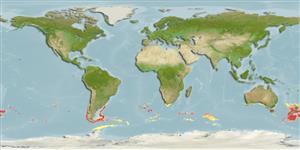Environment: milieu / climate zone / depth range / distribution range
Ecologia
marino batidemersale; non migratori; distribuzione batimetrica 200 - 1200 m, usually 500 - 800 m (Ref. 1371). Deep-water; 34°S - 65°S, 180°W - 180°E (Ref. 1371)
Southern Atlantic, Indian and Pacific: Subantarctic to temperate waters on both sides of South America, Falkland Islands, Discovery Tablemount and Meteor Seamount, South Africa, off Crozet and Prince Edward Islands, and off New Zealand and Macquarie Island.
Length at first maturity / Size / Peso / Age
Maturity: Lm 57.5, range 55 - 60 cm
Max length : 100.0 cm TL maschio/sesso non determinato; (Ref. 1371); Età massima riportata: 19 anni (Ref. 7059)
Spine dorsali (totale) : 2; Spine anali: 0. Head short, its underside moderately to extensively scaled, but sometimes only a file or narrow band of small scales is present below the suborbital and preopercular ridges and posteriorly on lower jaw. Eyes relatively large. Snout short, moderately pointed, with small naked patches on dorsal surface behind leading edges. Pyloric caeca 13 to 21. Overall color is medium brown to somewhat straw color; fins darker, blackish in some; the dorsal and pelvic fins darker distally; oral cavity lining dark gray or brown.
A benthic species found on the continental slope (Ref. 75154). This species is being imported and sold to the United States by the Argentines under the name grenadero (Ref. 5171).
Life cycle and mating behavior
Maturities | Riproduzione | Spawnings | Egg(s) | Fecundities | Larve
Cohen, D.M., T. Inada, T. Iwamoto and N. Scialabba, 1990. FAO species catalogue. Vol. 10. Gadiform fishes of the world (Order Gadiformes). An annotated and illustrated catalogue of cods, hakes, grenadiers and other gadiform fishes known to date. FAO Fish. Synop. 125(10). Rome: FAO. 442 p. (Ref. 1371)
IUCN Red List Status (Ref. 130435)
Threat to humans
Harmless
Human uses
Pesca: commerciale
Strumenti
Special reports
Download XML
Fonti Internet
Estimates based on models
Preferred temperature (Ref.
123201): 3.2 - 8.1, mean 6.7 °C (based on 164 cells).
Phylogenetic diversity index (Ref.
82804): PD
50 = 0.5312 [Uniqueness, from 0.5 = low to 2.0 = high].
Bayesian length-weight: a=0.00282 (0.00170 - 0.00467), b=3.18 (3.03 - 3.33), in cm total length, based on LWR estimates for this species & (Sub)family-body (Ref.
93245).
Trophic level (Ref.
69278): 3.7 ±0.58 se; based on food items.
Resilienza (Ref.
120179): Basso, tempo minimo di raddoppiamento della popolazione 4.5 - 14 anni (tmax=19).
Fishing Vulnerability (Ref.
59153): High vulnerability (60 of 100).
Nutrients (Ref.
124155): Calcium = 19.5 [11.2, 47.6] mg/100g; Iron = 0.456 [0.212, 0.944] mg/100g; Protein = 16.9 [14.7, 19.1] %; Omega3 = 0.219 [0.102, 0.454] g/100g; Selenium = 28.6 [11.1, 65.6] μg/100g; VitaminA = 7.71 [1.54, 36.85] μg/100g; Zinc = 0.293 [0.188, 0.453] mg/100g (wet weight);
